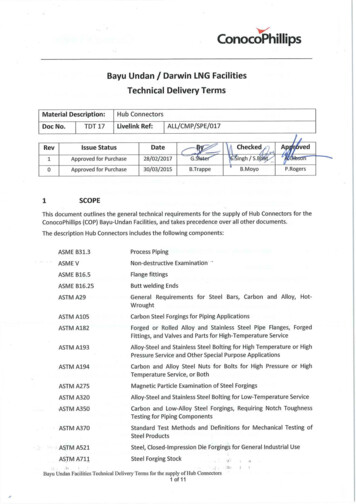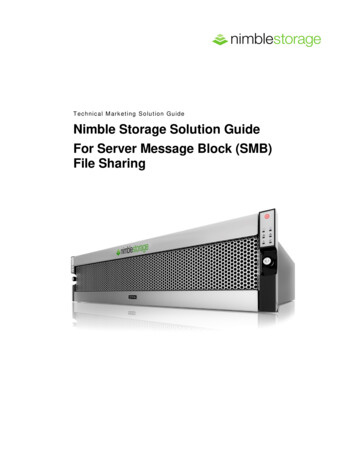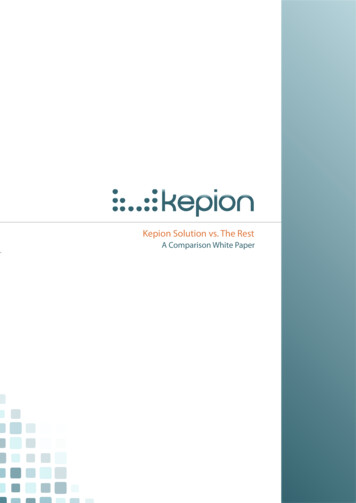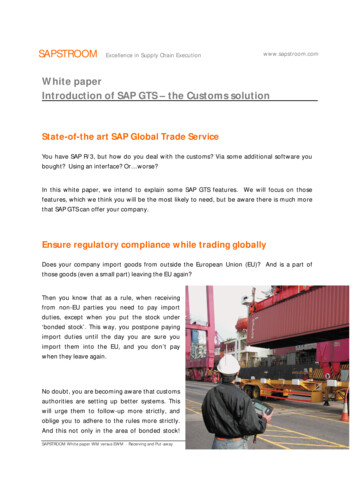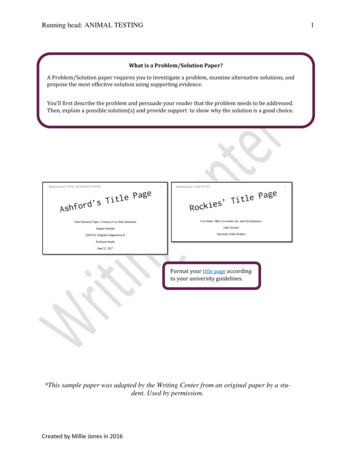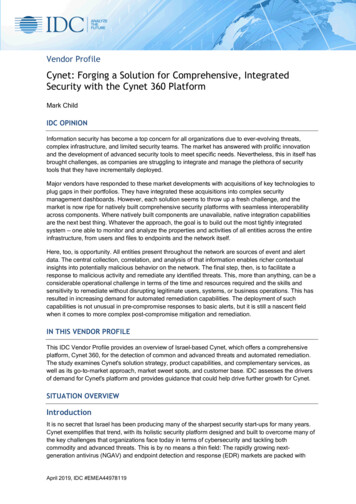
Transcription
Vendor ProfileCynet: Forging a Solution for Comprehensive, IntegratedSecurity with the Cynet 360 PlatformMark ChildIDC OPINIONInformation security has become a top concern for all organizations due to ever-evolving threats,complex infrastructure, and limited security teams. The market has answered with prolific innovationand the development of advanced security tools to meet specific needs. Nevertheless, this in itself hasbrought challenges, as companies are struggling to integrate and manage the plethora of securitytools that they have incrementally deployed.Major vendors have responded to these market developments with acquisitions of key technologies toplug gaps in their portfolios. They have integrated these acquisitions into complex securitymanagement dashboards. However, each solution seems to throw up a fresh challenge, and themarket is now ripe for natively built comprehensive security platforms with seamless interoperabilityacross components. Where natively built components are unavailable, native integration capabilitiesare the next best thing. Whatever the approach, the goal is to build out the most tightly integratedsystem — one able to monitor and analyze the properties and activities of all entities across the entireinfrastructure, from users and files to endpoints and the network itself.Here, too, is opportunity. All entities present throughout the network are sources of event and alertdata. The central collection, correlation, and analysis of that information enables richer contextualinsights into potentially malicious behavior on the network. The final step, then, is to facilitate aresponse to malicious activity and remediate any identified threats. This, more than anything, can be aconsiderable operational challenge in terms of the time and resources required and the skills andsensitivity to remediate without disrupting legitimate users, systems, or business operations. This hasresulted in increasing demand for automated remediation capabilities. The deployment of suchcapabilities is not unusual in pre-compromise responses to basic alerts, but it is still a nascent fieldwhen it comes to more complex post-compromise mitigation and remediation.IN THIS VENDOR PROFILEThis IDC Vendor Profile provides an overview of Israel-based Cynet, which offers a comprehensiveplatform, Cynet 360, for the detection of common and advanced threats and automated remediation.The study examines Cynet's solution strategy, product capabilities, and complementary services, aswell as its go-to-market approach, market sweet spots, and customer base. IDC assesses the driversof demand for Cynet's platform and provides guidance that could help drive further growth for Cynet.SITUATION OVERVIEWIntroductionIt is no secret that Israel has been producing many of the sharpest security start-ups for many years.Cynet exemplifies that trend, with its holistic security platform designed and built to overcome many ofthe key challenges that organizations face today in terms of cybersecurity and tackling bothcommodity and advanced threats. This is by no means a thin field: The rapidly growing nextgeneration antivirus (NGAV) and endpoint detection and response (EDR) markets are packed withApril 2019, IDC #EMEA44978119
innovative vendors and solutions attempting to solve the problem of monitoring host activity andprocess execution to prevent initial compromise and uncover undetected malicious presence.Another approach is the use of network analytics tools that seek to detect active breaches byanalyzing network traffic, establishing a behavioral baseline, and detecting anomalous behavior orindicators of compromise (IoCs). This type of analytical approach is integral to the fast-growing userand entity behavior analysis (UEBA) segment. Cynet's 360 platform seeks to deliver all thesecapabilities through a comprehensive integrated suite, with all security functionalities unified in a singleinterface to deliver effective, simplified operations and an optimal user experience.Company OverviewCynet was founded in 2015. Its cofounders came from the field of offensive cybersecurity and have astrong awareness of the multitudes of vulnerabilities and threat vectors that hackers look to exploit.The company and its solution have rapidly grown in reputation due to a few key factors: Cynet built a unified solution from the ground up, unhampered by legacy code or componentsthat create challenges for integration. The company focuses on delivering the fundamental capabilities that enable organizations toexecute security functions rather than simply mapping development to established marketcategories. Cynet's platform, Cynet 360, enables customers to move away from siloed security productsthat leave blind spots within an organization's infrastructure and activity. Cynet's platform unifies all security functionalities through a single user interface, enablingeffective security management for the security operations team. The platform provides granularly automated remediation for incidents even in postcompromise stages, significantly enhancing mitigation and recovery.In 2016, the company received 7 million in start-up funding from a U.S.-based hedge fund. In 2018, itreceived a further 13 million in Series B round funding to help continue its rapid growth. The vendoremploys around 90 people. Research, engineering, and support teams comprise around 60% of itsheadcount, with most of the remainder in sales and marketing.By the end of 2017, Cynet had built up a client base of around 80 companies worldwide. As of 2019,the figure is in the hundreds. The vendor's client base spans multiple geographies, verticals, and sizesegments. One of the largest clients is insurer Allianz, which uses Cynet's platform to protect around150,000 endpoints. The smallest are midmarket companies — typically, with around 400–500endpoints. Other references include retailer Carrefour, UniCredit Bank, Catalina (a U.S shopperintelligence and personalized digital media), Flugger (a Scandinavian paint company), PLDT (aleading Philippine telecommunications provider), and ICL (international manufacturer of chemicals).The upper midmarket represents something of a sweet spot for the vendor. Such companies are morelikely to look for a single security solution to cover all their needs (whereas large enterprises typicallylook to multiple solutions). In geographic terms, the vendor has a strong customer presence in Europe,the Philippines, the United States, and Israel.Company StrategyThe dynamic threat landscape, characterized by the increasing volume, variety, and sophistication ofthreats, has driven waves of security innovation and the emergence of new protection technologies.Although each technology has specific benefits, the result is that organizations now possess complexsecurity stacks that often do not work well together. This, in turn, requires budget, staffing, skills, andtime to manage. Cynet has responded to this operational burden with an integrated solution thataddresses many security challenges facing organizations, including: Unattended Alerts: Manual breach protection workflows can result in unaddressed securityevents as alert volumes surpass the security team's alert-handling capacity. 2019 IDC#EMEA449781192
Security Team Size and Skills: Advanced threat detection products may require costly andhard-to-find security skills for effective operation. Integration Overhead: Deploying multiple disparate products, each providing partial coverage,necessitates an additional aggregation layer (e.g., a security intelligence and eventmanagement system, or SIEM) for management and consolidated threat visibility. Deployment and Maintenance: The need to deploy and maintain multiple products creates anoperational burden that can lead to slow or partial deployment, leaving the organizationexposed to attacks.One of Cynet's guiding principles is its focus on root causes that prevent organizations from beingsecure from breaches. These causes include: Partial and siloed security products that do not cover an organization's entire environment(leaving blind spots in some areas and overlaps in others) Manual post-compromise protection, which leads to longer mean times to remediation andgreater risk of lateral movement and data exfiltrationWith their backgrounds in offensive cybersecurity, Cynet's cofounders understand well that anorganization's attack surface comprises far more than endpoints. Attackers can see many othervectors — a framework of attack surfaces that includes everything from stolen credentials and privilegeescalation to rootkits and memory injection. Consequently, Cynet developed its platform as a fullyconverged suite of security technologies, including endpoint protection, NGAV, user-behavior analysis,EDR, vulnerability management, network analysis, and deception. Cynet uses terms like EDR in itsmarketing, but it should be emphasized that the vendor focuses on developing the requiredcapabilities rather than mapping technologies. Cynet aims to provide the widest possible attack-vectorcoverage across all attack stages from its single platform.Cynet has scaled up rapidly. The vendor is small, flexible, and very focused. Cynet is not looking toreplace inbound/outbound traffic protection, such as firewalls (although it can upload scripts tofirewalls for remediation). Rather, the vendor focuses on internal environments, continuouslymonitoring and analyzing process execution, host behavior, user log-on activity, and network traffic. Ofcourse, in the digital transformation (DX) era, this raises questions about mobility and remote access —an area in which Cynet is still developing. Notebook PCs outside the corporate network are protected,as most of the threat protection mechanisms operate autonomously on the agent. Cynet does not yetprovide protection for mobile devices like smartphones and tablets. This is something the vendor willneed to add in the future as these devices become an increasingly targeted entry point forcybercriminals seeking to penetrate the corporate perimeter. However, as noted above, being smalland agile may be an advantage as the vendor seeks to develop and integrate these capabilities into itsplatform.Key DifferentiatorsCynet emphasizes the benefits of its ground-up development approach in building a truly unifiedplatform that effectively delivers numerous essential security capabilities through a single userinterface. The vendor's platform approach brings it into competition with some well-established marketleaders (e.g., McAfee, Symantec, and Microsoft), which have had many years to build out theircomprehensive platforms. Nevertheless, Cynet notes that building native integrations of non-native(i.e., acquired) components is very demanding: They need to be stripped down to the core, rewritten,integrated, and rebuilt. Even then, the acquiring vendor may still end up with some relatively disparateproducts or modules that are only unified on the management interface. Cynet's determination to buildeverything from scratch has resulted in a solution with seamless integration between all itscomponents and functionalities — a significant benefit for security professionals using the solution.As previously noted, Cynet places considerable emphasis on post-compromise protection. The vendoris striving to be a trailblazer in the field of automated discovery and mitigation. Automated remediation 2019 IDC#EMEA449781193
in the early stages of an attack might mean simply killing a process or limiting access rights, andnumerous solutions are already available on the market that can provide this level of orchestration.However, post-compromise remediation can be more complex, once hackers have progressed beyondreconnaissance into, for example, privilege escalation or lateral movement. At this stage, theorganization might need to isolate a host or disable user accounts, which can have more significantimplications. Consequently, many organizations tend toward the mindset that post-compromisemalicious activity is best detected and addressed with manual triage, investigation, and remediation(often augmented with EDR, UEBA, and network analytics tools).For clients, automated remediation at this stage can be daunting: They may face significantoperational risks if a key system is quarantined or users are frozen out of an application. Many ofCynet's customers prefer to start with its automated remediation capabilities switched off. Once anevent type has been successfully and correctly detected multiple times, then they may switch on theautomated remediation for that event type. This granular addition of automation is a key benefit ofCynet's platform. Customers, for example, might aim for an 80:20 approach, whereby the goal isautomated remediation for the 80% of alerts that pertain to low-value assets or have a low impact.Manual intervention is retained for the 20% of alerts and incidents that impact high-value assets. Notethat, even when organizations opt for a manual response to specific types of alerts, the Cynet systemstill provides full context and insights regarding the scope and impact of the malicious activity, as wellas guidance and tools for remediation. The degree to which automated remediation is adopteddepends on many factors — company culture, vertical market, geography, and regulation — but,ultimately, the customer organization has the choice to automate as much (or as little) as it wants.In addition to its autonomous agent-based threat prevention and detection, Cynet conducts correlationand analysis on the server layer. Each customer runs a correlation engine, either on a server deployedon premises or in the cloud. This engine collects information from the agents, including assetidentifiers, activity data, and alert data. A further level of analysis runs on Cynet's private cloud-basedcentral engine. This ingests and analyzes threat feeds, which are uploaded from the client-basedcorrelation engines via hashes and compared against other incoming feeds to analyze events in aneven broader context. Communication between the customer servers and main Cynet server takesplace in one of two ways: The local servers query Cynet's server when encountering suspiciousactivity that they cannot validate locally; or, once a new IoC, signature, or prevention/detectionmechanism is uploaded to the main Cynet server, the server pushes the new configuration to all localservers as a response.Upon deployment at a new customer entity (which can take as little as two hours), Cynet maps theorganization's entire network, devices, and dependencies. One of the benefits of this approach is thatits system can even address, to some extent, endpoints where it does not have an agent. The systemmaps that the device exists and can establish a baseline for its behavior. If the device deviates fromthat baseline, it can be isolated and quarantined or an alert triggered.For this study, Cynet demoed its platform for IDC. The interface is intuitive: After deployment of thesolution and the mapping of the customer's network, security admins are presented with acomprehensive network topology overview, with the ability to view the entire network or zoom in onspecific host groups. With a single click, the user can zoom in on any individual asset and get anoverview of all its properties (e.g., configuration and installed software), dependencies, and activities,from the time of the initial scan to the present view time.Cynet also provides a 360-degree alert view, which shows the threat activity status across the entireenvironment, including files, network, users, and hosts. Each alert is classified as either critical, high,midrange, or low, based on the level of manifested malicious presence or activity. The home screenincludes a threat radar that shows high and critical alerts only, but alerts can easily be filteredmanually, either from the alert screen or when zooming in on assets (files, hosts, users, and network).Again, a single click can drill down into any alert, showing the affected asset (or assets) and the 2019 IDC#EMEA449781194
activity of any compromise or attempted breach. The next level presents the security administrator oranalyst with remediation options, with both manual and automated remediation options available. Thesystem also provides file analyses, sandbox sample analyses, and more, all managed through itssingle user interface. This provides the customer organization with insights and context aroundmalicious activity affecting its systems and networks, enabling it to respond to current threats moreeffectively and be more prepared for whatever may come next.SWAT SupportCynet reinforces its 360 platform with a 24 x 7 Cyber SWAT team, called CyOps, as an integrated partof its offering (not a paid add-on). The team provides threat hunting across customer environments,incident response assistance, file analysis, and other incident investigation services. The front linecomprises a team of 10–15 analysts on shifts, backed up by a team of top security researchers andmultiple threat feeds. All these elements combine into a real-time value product and a real-time threatlandscape feed.Open for IntegrationAlthough Cynet has designed and built its platform as a comprehensive threat prevention solution, thevendor recognizes opportunities in mature organizations that have developed security infrastructure. Inthese cases, Cynet can be deployed as an EPP and EDR solution and integrated with the existingsecurity stack, sending alerts to the client's SIEM or log analysis tool, which will continue to serve asthe main organizational security backbone. Even in its standard deployment model (i.e., when theCynet platform is the main backbone and the client utilizes all its prevention and detectionfunctionalities), Cynet still ingests data feeds from firewalls, proxies, Active Directory, and more.Doubling Up — With DeceptionAlthough deception as a military technique has existed since Sun Tzu, in the field of cybersecurity, it isstill only gradually gaining traction on the market. This is due, in part, to the demanding nature ofrunning and updating deception solutions, which must be regularly rejuvenated to keep them fresh. Todate, Cynet has provided deception capabilities using decoy files and folders placed within the networkto attract attackers. Once an attacker accesses one of these files or folders, it sets off alerts andtriggers tracking mechanisms that enable the client to track the attacker's activity. As a further step inits development, Cynet is now adding decoy nodes and servers to its deception capabilities toenhance the deception and increase the likelihood of attracting and detecting hackers within thenetwork.Business StrategyCynet highlights two customer groups that are particularly responsive to its value proposition: Large Organizations: Despite their size, some large organizations may not sustain a largeenough security team. Cynet enables these organizations to gain protection from bothstandard and advanced threats within their existing resources. Medium-Sized Organizations: With basic security in place, these organizations are looking forprotection from advanced threats that traditional antivirus and firewall cannot confront. Cynet'ssolution can either be used to augment the existing antivirus or replace it altogether.Cynet has three distinct go-to-market approaches. In Europe, the company maintains a large fieldsales team that works with channel partners and primarily targets the enterprise space. The focus inthe U.S. is on the midmarket, which is targeted mostly by the vendor's inside sales team. The thirdapproach is established partnerships with leading managed security service providers (MSSPs). 2019 IDC#EMEA449781195
FUTURE OUTLOOKThe proliferation of security toolsets and integrated stacks to provide advanced threat protection, inresponse to the operational needs of end-user organizations, is driv
One of the largest clients is insurer Allianz, which uses Cynet'splatformto protect around 150,000 endpoints. The smallest are midmarket companies—typically,with around 400–500 endpoints. Other references include retailer Carrefour, UniCredit Bank, Catalina (a U.S shopper . (DX)era, this raises qu

